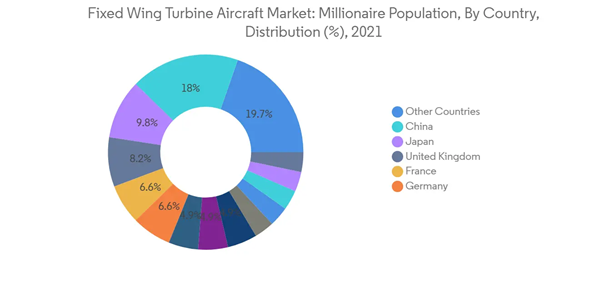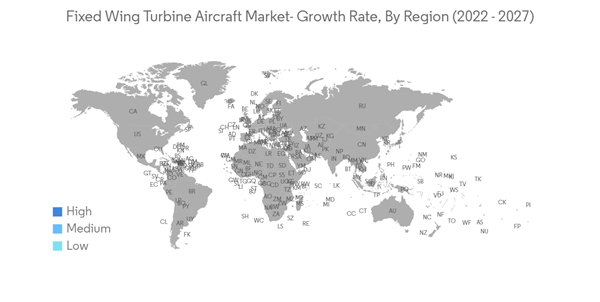Fixed Wing Turbine Aircraft Market is projected to register a CAGR of 5.2% during the forecast period.
The COVID-19 pandemic affected air passenger traffic globally in 2020, reducing flight activity and impacting domestic and international travel. As a result, private aircraft OEMs trimmed their production rates as the pandemic decreased the demand for new jets. However, after the COVID-19 pandemic, the restrictions on traveling rules and regulations were reduced. Furthermore, with the increased use of turbine-powered aircraft for training and recreational activities, along with regional travel, the demand for these aircraft grew by significant margins, with a steady increase. Owing to this, the market has witnessed a gradual economic revival from the economic slump caused due to the pandemic.
There were 56.1 million High-Net-Worth Individuals (HNWI) across the world at the end of 2021. This represents around 1.1% of the world’s adult population, driving significant demands for market growth, and is expected to drive market growth during the forecast period.
Opting for a private aircraft is an efficient and cost-effective solution for UHNWIs to cater to their busy schedules across multiple countries and time zones.
Although the UHNWIs in the United States dominated the private aviation market for decades, regulatory changes in the emerging economies have resulted in the internationalization of the demand for private aviation. Middle Eastern UHNW individuals prefer to buy more expensive planes than their counterparts, nearly 2.5 times higher than the global average, primarily due to their luxury requirements.
Asia-Pacific confirmed its status as a repository of high-net-worth individuals, with a major portion of the new high-net-worth individual (HNWI) wealth globally. The private aviation industry in Asia-Pacific has been growing rapidly, largely due to the region’s rapidly growing digital and high-tech economy, which generated a pool of wealth among young entrepreneurs. The region’s private jet charter market’s growth has been on par with the global charter market. Compared to complete ownership, there is an increasing demand for chartering and fractional membership in Asia-Pacific.
Thus, the factors, like the increasing number of HNWIs and the developing economy has been the main driver for the purchase of business jets. Though the COVID-19 pandemic has affected the wealth of these populations at least in some countries, the overall impact of the pandemic on a majority of the UHNWI is deemed to be less, which is a positive sign for the business jet industry.
The GDP of Asian countries like China, and India has shown good growth in terms of GDP and economic development. For instance, For India, Nominal GDP or GDP at Current Prices in Q1 2022-23 is estimated at INR 64.95 lakh crore, as against INR 51.27 lakh crore in Q1 2021-22, showing a growth of 26.7 percent as compared to 32.4 percent in Q1 2021-22.
As of 2021, Asia-Pacific accounted for the highest number of ultra-high-net-worth individuals, with 831 (38%) of the super-rich residing in the region, where billionaire wealth now totals $3.3 trillion. Mainland China emerged as the region’s top market for wealth creation, with 415 billionaires, followed by India (114), Hong King (65) Taiwan (40).
As the high net population increases in the region, the number of business jets also increases, for instance, As of March 2021, Japan had a total fleet of 97 business jets. In 2020, two new business jets were added to the country’s fleet, down from seven jets a year ago. One of the jets was a large jet, while the other is a mid-size jet.
Considering the economic development of the Asia-pacific region and the increased number of millionaires in the Asia-pacific will grow market in the coming years.
In July 2022, Textron Aviation’s defense division was awarded a USD 90 million US Air Force contract modification to provide Tunisia with eight T-6C turboprops. In July 2022, the militarised version of the Cessna Citation Longitude boasts a 3,500nm range and a suite of sensors for security and law enforcement purposes.
Consequently, the aircraft providers will witness a competitive advantage in terms of market penetration and market share.
This product will be delivered within 2 business days.
The COVID-19 pandemic affected air passenger traffic globally in 2020, reducing flight activity and impacting domestic and international travel. As a result, private aircraft OEMs trimmed their production rates as the pandemic decreased the demand for new jets. However, after the COVID-19 pandemic, the restrictions on traveling rules and regulations were reduced. Furthermore, with the increased use of turbine-powered aircraft for training and recreational activities, along with regional travel, the demand for these aircraft grew by significant margins, with a steady increase. Owing to this, the market has witnessed a gradual economic revival from the economic slump caused due to the pandemic.
There were 56.1 million High-Net-Worth Individuals (HNWI) across the world at the end of 2021. This represents around 1.1% of the world’s adult population, driving significant demands for market growth, and is expected to drive market growth during the forecast period.
Fixed Wing Turbine Aircraft Market Trends
Business Jet Segment Will Drive the Market Due to Increase in High-net-worth Individuals
HNWIs enjoy a global lifestyle, and extensive air travel is often a requirement for them. They are active players in the global general aviation market and often opt for fractional ownership or charter private planes, apart from owning private aircraft. However, a section of the wealthy population also opts for ownership, either individually or commercially.Opting for a private aircraft is an efficient and cost-effective solution for UHNWIs to cater to their busy schedules across multiple countries and time zones.
Although the UHNWIs in the United States dominated the private aviation market for decades, regulatory changes in the emerging economies have resulted in the internationalization of the demand for private aviation. Middle Eastern UHNW individuals prefer to buy more expensive planes than their counterparts, nearly 2.5 times higher than the global average, primarily due to their luxury requirements.
Asia-Pacific confirmed its status as a repository of high-net-worth individuals, with a major portion of the new high-net-worth individual (HNWI) wealth globally. The private aviation industry in Asia-Pacific has been growing rapidly, largely due to the region’s rapidly growing digital and high-tech economy, which generated a pool of wealth among young entrepreneurs. The region’s private jet charter market’s growth has been on par with the global charter market. Compared to complete ownership, there is an increasing demand for chartering and fractional membership in Asia-Pacific.
Thus, the factors, like the increasing number of HNWIs and the developing economy has been the main driver for the purchase of business jets. Though the COVID-19 pandemic has affected the wealth of these populations at least in some countries, the overall impact of the pandemic on a majority of the UHNWI is deemed to be less, which is a positive sign for the business jet industry.
Asia Pacific is Expected to Lead the Market During the Forecast Period
Out of the total percentage of a millionaire in the world, 17% of the percentage comes from Asia pacific region which is 10,755 thousand people.The GDP of Asian countries like China, and India has shown good growth in terms of GDP and economic development. For instance, For India, Nominal GDP or GDP at Current Prices in Q1 2022-23 is estimated at INR 64.95 lakh crore, as against INR 51.27 lakh crore in Q1 2021-22, showing a growth of 26.7 percent as compared to 32.4 percent in Q1 2021-22.
As of 2021, Asia-Pacific accounted for the highest number of ultra-high-net-worth individuals, with 831 (38%) of the super-rich residing in the region, where billionaire wealth now totals $3.3 trillion. Mainland China emerged as the region’s top market for wealth creation, with 415 billionaires, followed by India (114), Hong King (65) Taiwan (40).
As the high net population increases in the region, the number of business jets also increases, for instance, As of March 2021, Japan had a total fleet of 97 business jets. In 2020, two new business jets were added to the country’s fleet, down from seven jets a year ago. One of the jets was a large jet, while the other is a mid-size jet.
Considering the economic development of the Asia-pacific region and the increased number of millionaires in the Asia-pacific will grow market in the coming years.
Fixed Wing Turbine Aircraft Market Competitor Analysis
The fixed-wing turbine aircraft market is consolidated, with major players holding a large share of the market. The prominent player in the market is Bombardier, Embraer, Boeing, Airbus, and, Textron Aviation. In the wake of the COVID-19 pandemic, defense organizations of several countries have been investing in increasing their fleet of fixed-wing turbine-powered aircraft. As a result, turbine-powered aircraft companies have been receiving orders for aircraft, increasing the market value and revenue influx into the market. For instance,In July 2022, Textron Aviation’s defense division was awarded a USD 90 million US Air Force contract modification to provide Tunisia with eight T-6C turboprops. In July 2022, the militarised version of the Cessna Citation Longitude boasts a 3,500nm range and a suite of sensors for security and law enforcement purposes.
Consequently, the aircraft providers will witness a competitive advantage in terms of market penetration and market share.
Additional benefits of purchasing the report:
- The market estimate (ME) sheet in Excel format
- 3 months of analyst support
This product will be delivered within 2 business days.
Table of Contents
1 INTRODUCTION
4 MARKET DYNAMICS
5 MARKET SEGMENTATION
6 COMPETITIVE LANDSCAPE
Companies Mentioned (Partial List)
A selection of companies mentioned in this report includes, but is not limited to:
- Bombardier Inc.
- Embraer S.A.
- Airbus SE
- Textron Aviation
- Pilatus Aircraft Ltd.
- Dassault Falcon Jet Corp.
- Gulfstream Aerospace Corporation
- The Boeing Company
- De Havilland Aircraft of Canada
Methodology

LOADING...










